A Decision-Making System for Cotton Irrigation Based on Reinforcement Learning Strategy
Abstract
:1. Introduction
2. Materials and Methods
2.1. Related Work
2.2. Study Region
2.3. Solar Radiation, Temperature, and Rainfall
2.4. Soil Data
2.5. DSSAT Model Description
2.6. Experimental Design
2.7. Reinforcement Learning Model
2.7.1. State
2.7.2. Action
| Algorithm 1 Max Yield Irrigation Optimization |
| Description: This algorithm aims to optimize the irrigation strategy by applying a greedy approach to maximize the yield for each period within a 20-period irrigation cycle. Input: initial irrigation strategy—initial irrigation strategy consisting of 20 irrigation periods and corresponding yield Output: Optimized irrigation strategy—the irrigation strategy that maximizes yield for each period Pseudo-code: Function Optimize Max Yield Irrigation (initial irrigation strategy): Initialize state vector to initial irrigation strategy Repeat the following process for 20 cycles: For each period in state vector: max yield = 0 best irrigation amount = 0 For each possible irrigation amount in current period: Calculate yield for the current irrigation amount If yield > max yield: max yield = yield best irrigation amount = current irrigation amount Update irrigation amount for the current period to best Irrigation amount Return the optimized irrigation strategy for maximum yield |
2.7.3. Reward
3. Results
4. Discussion
5. Conclusions
Author Contributions
Funding
Data Availability Statement
Conflicts of Interest
References
- Yang, Y.; Yang, Y.; Han, S.; Macadam, I.; Liu, D.L. Prediction of cotton yield and water demand under climate change and future adaptation measures. Agric. Water Manag. 2014, 144, 42–53. [Google Scholar] [CrossRef]
- Adhikari, P.; Ale, S.; Bordovsky, J.P.; Thorp, K.R.; Barnes, E.M. Simulating future climate change impacts on seed cotton yield in the Texas High Plains using the CSM-CROPGRO-Cotton model. Agric. Water Manag. 2016, 164, 317–330. [Google Scholar] [CrossRef]
- Chen, X.; Qi, Z.; Gui, D.; Gu, Z.; Ma, L.; Zeng, F.; Li, L. Simulating impacts of climate change on cotton yield and water requirement using RZWQM2. Agric. Water Manag. 2019, 222, 231–241. [Google Scholar] [CrossRef]
- Asmaa, M.; Elpiniki, P.; Konstantinos, K.; Tajjeeddine, R. Exploring Precision Farming Scenarios Using Fuzzy Cognitive Maps. Sustainability 2017, 9, 1241. [Google Scholar]
- Parrazales, R.U.; Álvarez, M.T.Z.; Cruz, K.A.A.; Orozco, R.P.; Muoz, J.L.F. Implementation of a Fuzzy Logic Controller for the Irrigation of Rose Cultivation in Mexico. Agriculture 2021, 11, 576. [Google Scholar] [CrossRef]
- Hunt, M.L.; Blackburn, G.A.; Carrasco, L.; Redhead, J.W.; Rowland, C.S. High resolution wheat yield mapping using Sentinel-2. Remote Sens. Environ. Interdiscip. J. 2019, 233, 111410. [Google Scholar] [CrossRef]
- Thorp, K.R.; DeJonge, K.C.; Kaleita, A.L.; Batchelor, W.D.; Paz, J.O. Methodology for the use of DSSAT models for precision agriculture decision support. Comput. Electron. Agric. 2008, 64, 276–285. [Google Scholar] [CrossRef]
- Jiang, Y.; Xu, X.; Huang, Q.; Huo, Z.; Huang, G. Optimizing regional irrigation water use by integrating a two-level optimization model and an agro-hydrological model. Agric. Water Manag. 2016, 178, 76–88. [Google Scholar] [CrossRef]
- Thorp, K.R.; Hunsaker, D.J.; Bronson, K.F.; Pedro, A.S.; Barnes, E.M. Cotton Irrigation Scheduling Using a Crop Growth Model and FAO-56 Methods: Field and Simulation Studies. Trans. ASABE 2017, 60, 2023–2039. [Google Scholar] [CrossRef]
- Kisekka, I.; Aguilar, J.P.; Rogers, D.H.; Holman, J.; O’Brien, D.M.; Klocke, N. Assessing deficit irrigation strategies for corn using simulation. Trans. ASAE Am. Soc. Agric. Eng. 2016, 59, 303–317. [Google Scholar]
- Pandian, P.S.; Parthiban, R.M.; Giri, S.S. Automation in Agriculture: An Innovative Approach. Int. J. Eng. Res. Technol. 2015, 4, 133–136. [Google Scholar]
- Zhang, X.; Wang, H.; Wang, B.; Wang, L.; Zhang, Q.; Zhang, X.; Zhang, W.; Zhang, L.; Zhang, Y.; Zhang, J.; et al. Agricultural drought over water-scarce Central Asia aggravated by internal climate variability. Nat. Geosci. 2021, 14, 737–742. [Google Scholar]
- Zhang, Y.; Li, Y.; Chen, S.; Han, X. An intelligent irrigation system based on wireless sensor networks and cloud computing. IEEE Access 2020, 8, 14880–14888. [Google Scholar]
- Zeng, Z.; Chen, J.; Gong, D. An intelligent irrigation system based on IoT and deep learning for agricultural sustainability. Sustainability 2019, 11, 624. [Google Scholar]
- Fang, Q.; Ma, L.; Green, T.R. Impacts of climate change on irrigation water requirements in the Columbia River Basin. J. Am. Water Resour. Assoc. 2013, 49, 1054–1071. [Google Scholar]
- Ko, J. Using EPIC Simulation Model to Manage Irrigated Crops. In Proceedings of the ASA-CSSA-SSA 2007 International Annual Meetings, New Orleans, LA, USA, 4–8 November 2007. [Google Scholar]
- Mccarthy, A.C.; Hancock, N.H.; Raine, S.R. Simulation of irrigation control strategies for cotton using Model Predictive Control within the VARIwise simulation framework. Comput. Electron. Agric. 2014, 101, 135–147. [Google Scholar] [CrossRef]
- Modala, N.R.; Ale, S.; Rajan, N.; Munster, C.; Barnes, E. Evaluation of the CSM-CROPGRO-Cotton model for the Texas rolling plains region and simulation of deficit irrigation strategies for increasing water use efficiency. Trans. ASABE 2015, 58, 685–696. [Google Scholar]
- Liu, C.; Qi, Z.; Gu, Z.; Gui, D.; Zeng, F. Optimizing Irrigation Rates for Cotton Production in an Extremely Arid Area Using RZWQM2-Simulated Water Stress. Trans. ASABE 2017, 60, 2041–2052. [Google Scholar] [CrossRef]
- Dejonge, K.C.; Thorp, K.R. Implementing Standardized Reference Evapotranspiration and Dual Crop Coefficient Approach in the DSSAT Cropping System Model. Trans. ASABE 2017, 60, 1965–1981. [Google Scholar] [CrossRef]
- Himanshu, S.K.; Ale, S.; Bordovsky, J.; Darapuneni, M. Evaluation of crop-growth-stage-based deficit irrigation strategies for cotton production in the Southern High Plains. Agric. Water Manag. 2019, 225, 105782. [Google Scholar] [CrossRef]
- Kothari, K.; Ale, S.; Bordovsky, J.P.; Thorp, K.R.; Porter, D.O.; Munster, C.L. Simulation of efficient irrigation management strategies for grain sorghum production over different climate variability classes. Agric. Syst. 2019, 170, 49–62. [Google Scholar] [CrossRef]
- Kothari, K.; Ale, S.; Bordovsky, J.; Munster, C.; Singh, V.; Nielsen-Gammon, J.; Hoogenboom, G. Potential genotype-based climate change adaptation strategies for sustaining cotton production in the Texas High Plains: A simulation study. Field Crops Res. 2021, 271, 108261. [Google Scholar] [CrossRef]
- Quah, K.H.; Quek, C.; Leedham, G. Reinforcement learning combined with a fuzzy adaptive learning control network (FALCON-R) for pattern classification. Pattern Recognit. 2005, 38, 513–526. [Google Scholar] [CrossRef]
- Ramesh, S.; Kannan, S.; Baskar, S. Application of Modified NSGA-II Algorithm to Multi-Objective Reactive Power Planning; Elsevier Science Publishers B.V.: Amsterdam, The Netherlands, 2012. [Google Scholar]
- Khalili-Damghani, K.; Tavana, M.; Sadi-Nezhad, S. An integrated multi-objective framework for solving multi-period project selection problems. Appl. Math. Comput. 2012, 219, 3122–3138. [Google Scholar] [CrossRef]
- Yicong, G.; Yixiong, F.; Qirui, W.; Hao, Z.; Jianrong, T. Multiobjective Decision Making: Theory and Methodology; Courier Dover Publications: Mineola, NY, USA, 2008; pp. 712–725. [Google Scholar]
- Wheeler, J.; Paez, M.A.; Guillen-Gosalbez, G.; Mele, F.D. Combining multi-attribute decision-making methods with multi-objective optimization in the design of biomass supply chains. Comput. Chem. Eng. Int. J. Comput. Appl. Chem. Eng. 2018, 113, 11–31. [Google Scholar] [CrossRef]
- Zhang, G.; Li, Z. A hybrid multi-objective optimization approach for energy-absorbing structures in train collisions. Inf. Sci. Int. J. 2019, 481, 491–506. [Google Scholar] [CrossRef]
- Piasecki, M.; Kostyrko, K. Development of Weighting Scheme for Indoor Air Quality Model Using A Multi-Attribute Decision Making Method. Energies 2020, 13, 3120. [Google Scholar]
- Yu, Y.; Tang, J.; Huang, J.; Zhang, X.; So, D.K.C.; Wong, K.K. Multi-Objective Optimization for UAV-Assisted Wireless Powered IoT Networks Based on Extended DDPG Algorithm. IEEE Trans. Commun. 2021, 69, 6361–6374. [Google Scholar] [CrossRef]
- Xu, W.; Meisalhi, S. Dynamic emergency route planning for major chemical accidents: Models and application. Saf. Sci. 2021, 135, 73–103. [Google Scholar] [CrossRef]
- Saad, O.M.; Biltagy, M.S.; Farag, T.B. An algorithm for multi objective integer nonlinear fractional programming problem under fuzziness. Gen. Math. Notes 2011, 1, 207–220. [Google Scholar]
- Jones, J.; Hoogenboom, G.; Porter, C.; Boote, K.; Batchelor, W.; Hunt, L.; Wilkens, P.; Singh, U.; Gijsman, A.; Ritchie, J. The DSSAT cropping system model. Eur. J. Agron. 2003, 18, 235–265. [Google Scholar] [CrossRef]
- Hoogenboom, G.; Porter, C.H.; Boote, K.J.; Shelia, V.; Jones, J.W. The DSSAT crop modeling ecosystem. In Advances in Crop Modelling for a Sustainable Agriculture; Burleigh Dodds Science Publishing: Sawston, UK, 2019. [Google Scholar]
- Sarkar, R. Decision Support Systems for Agrotechnology Transfer; Springer: Amsterdam, The Netherlands, 2012. [Google Scholar]
- Adhikari, P.; Gowda, P.H.; Marek, G.W.; Brauer, D.K.; Kisekka, I.; Northup, B.; Rocateli, A. Calibration and Validation of CSM-CROPGRO-Cotton Model Using Lysimeter Data in the Texas High Plains. J. Contemp. Water Res. Educ. 2017, 162, 61–78. [Google Scholar] [CrossRef]
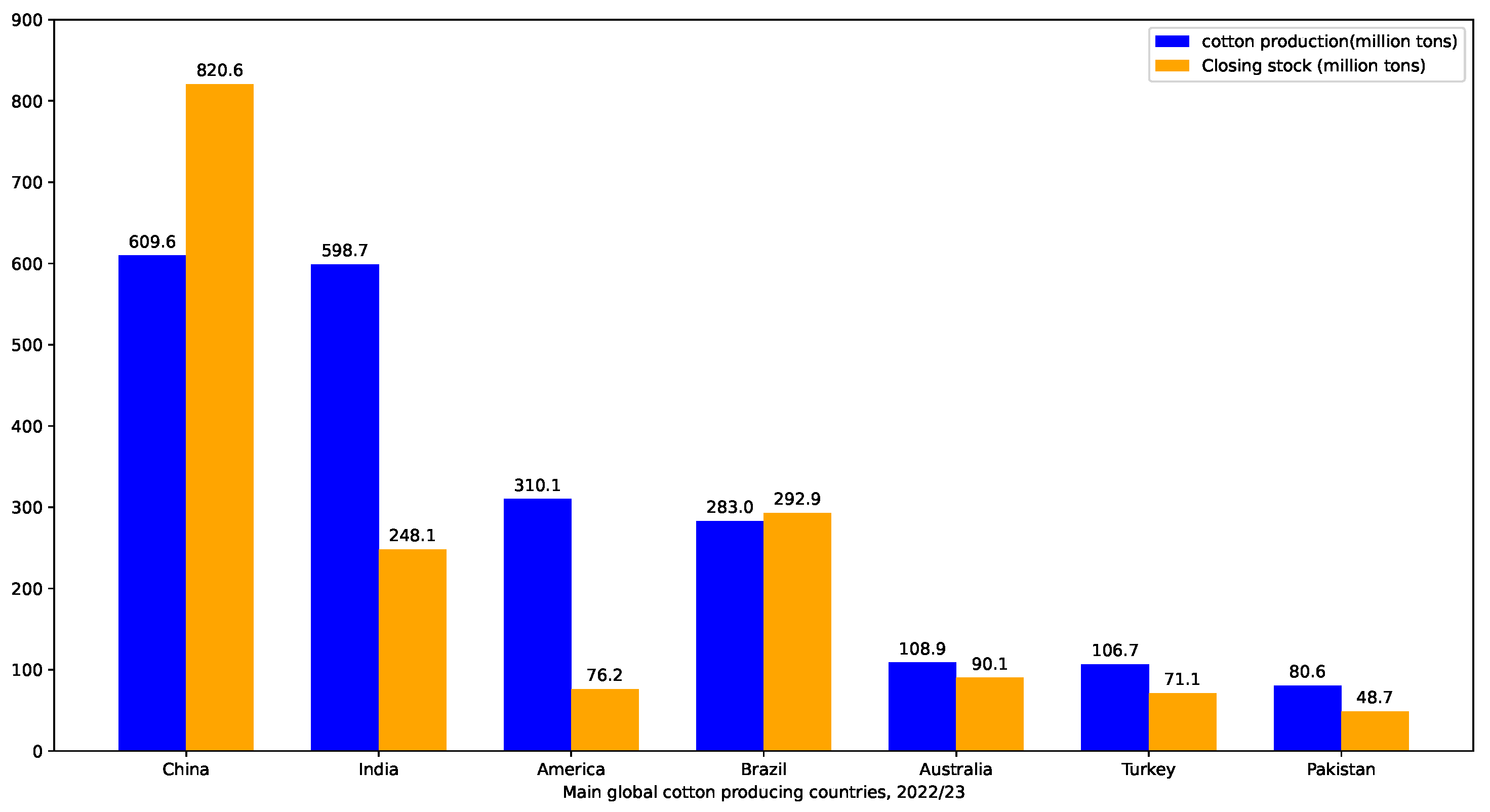
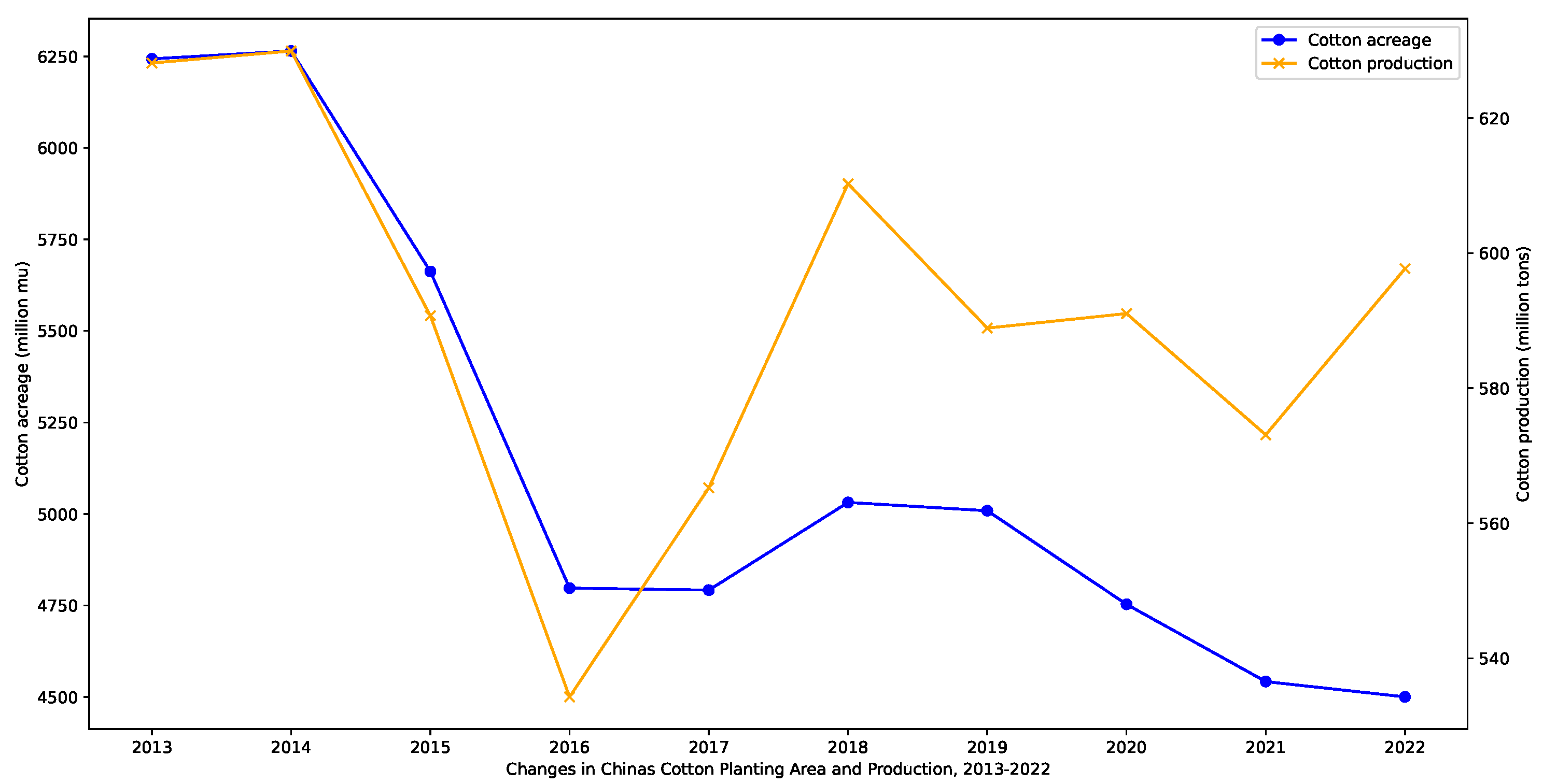
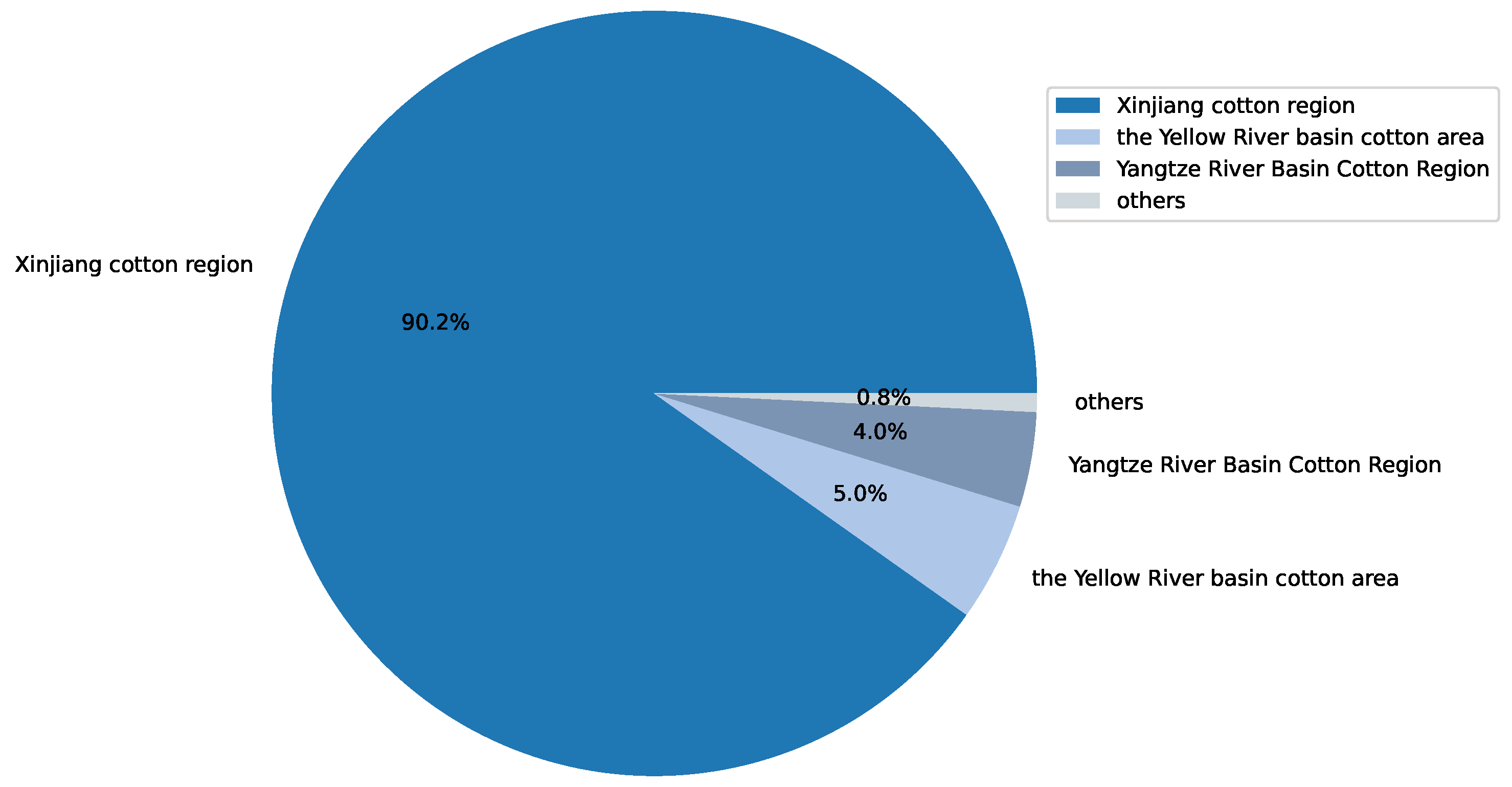
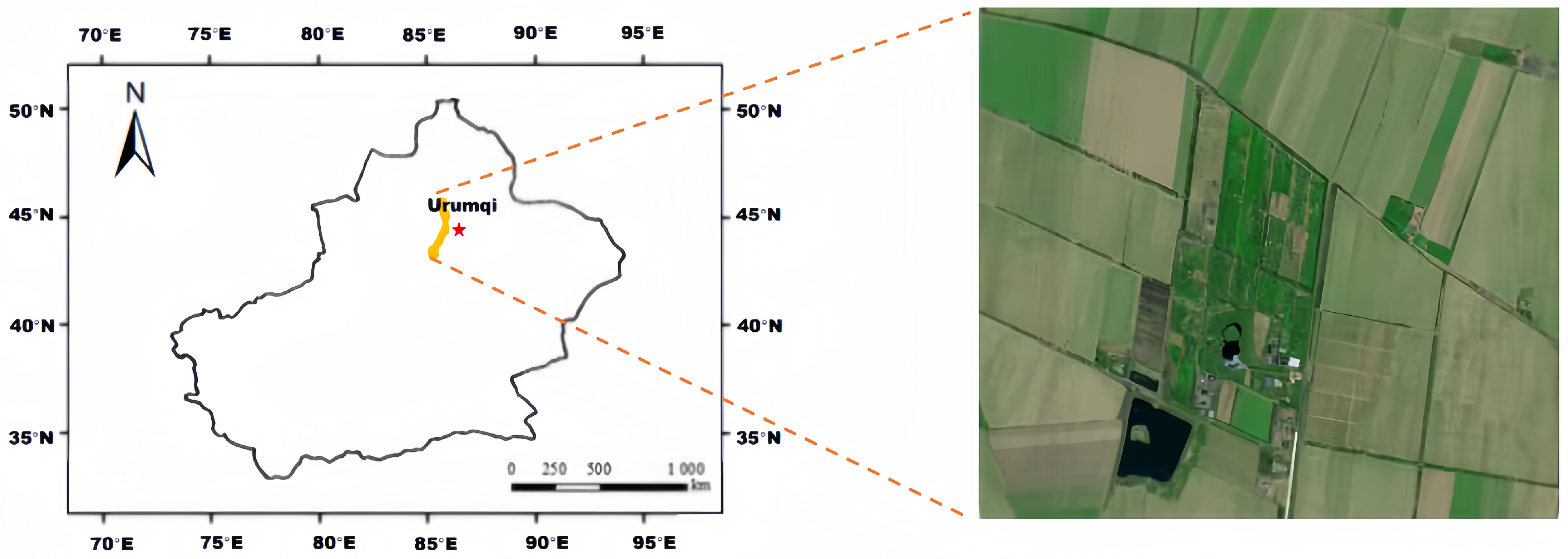
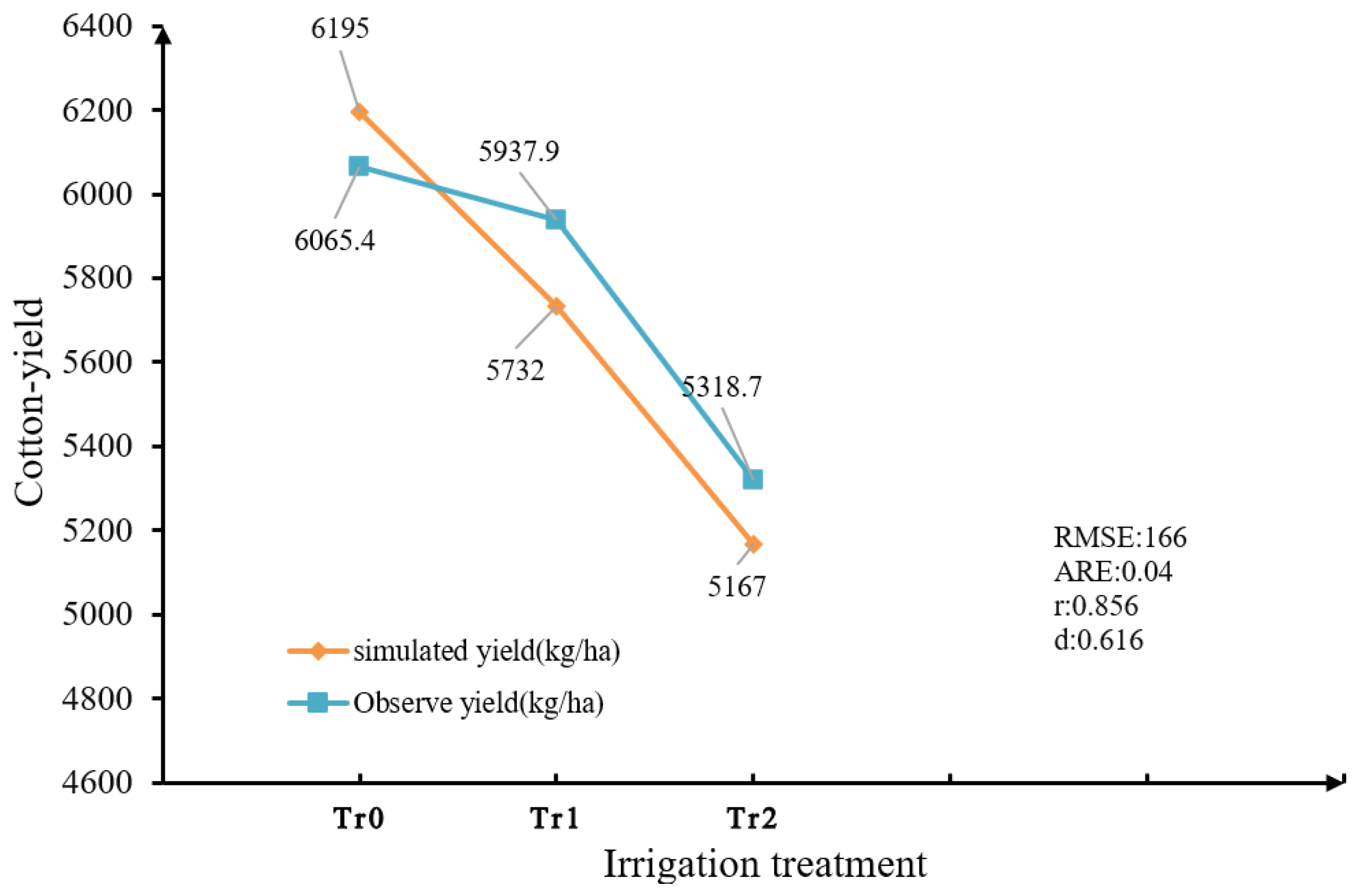

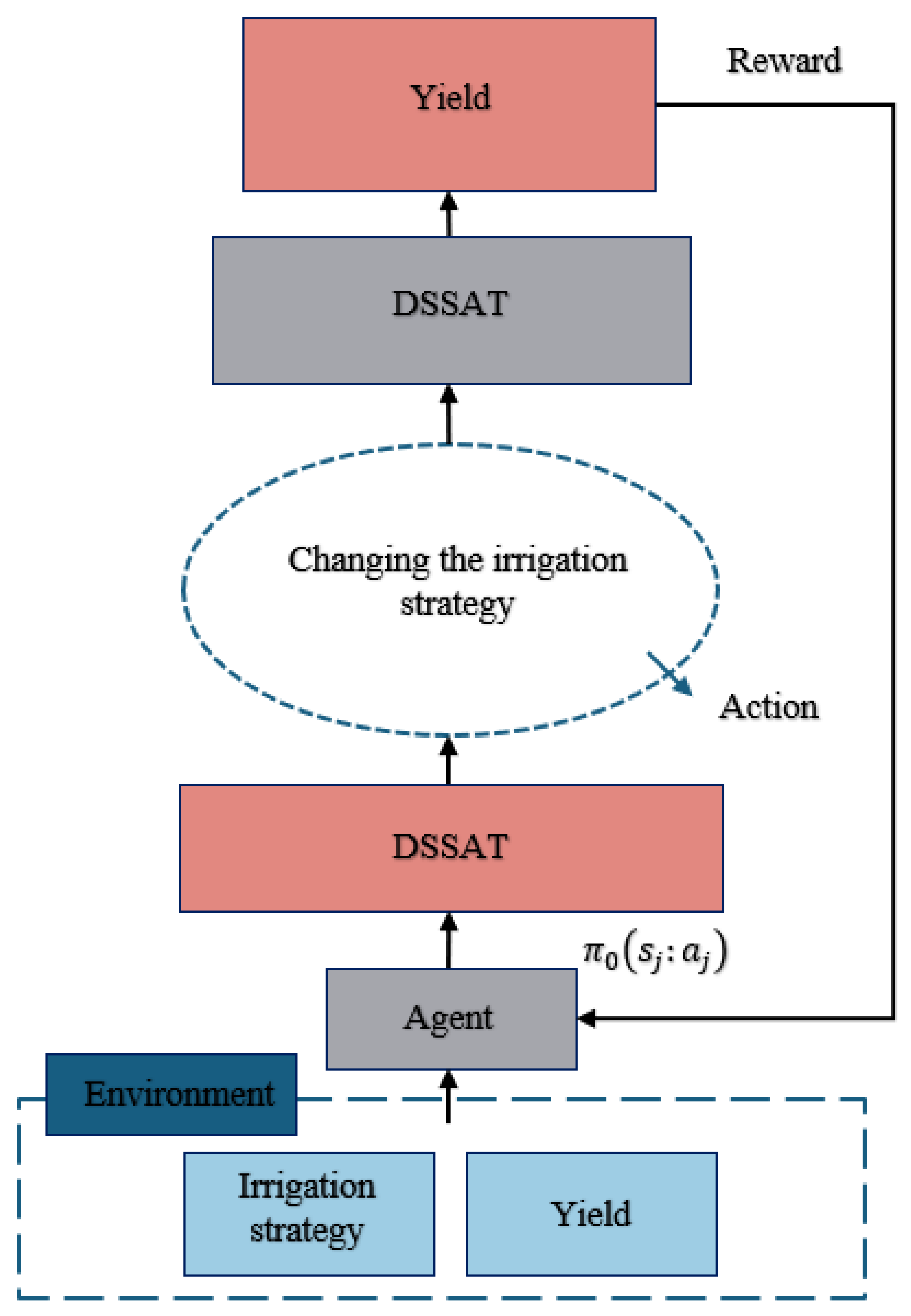
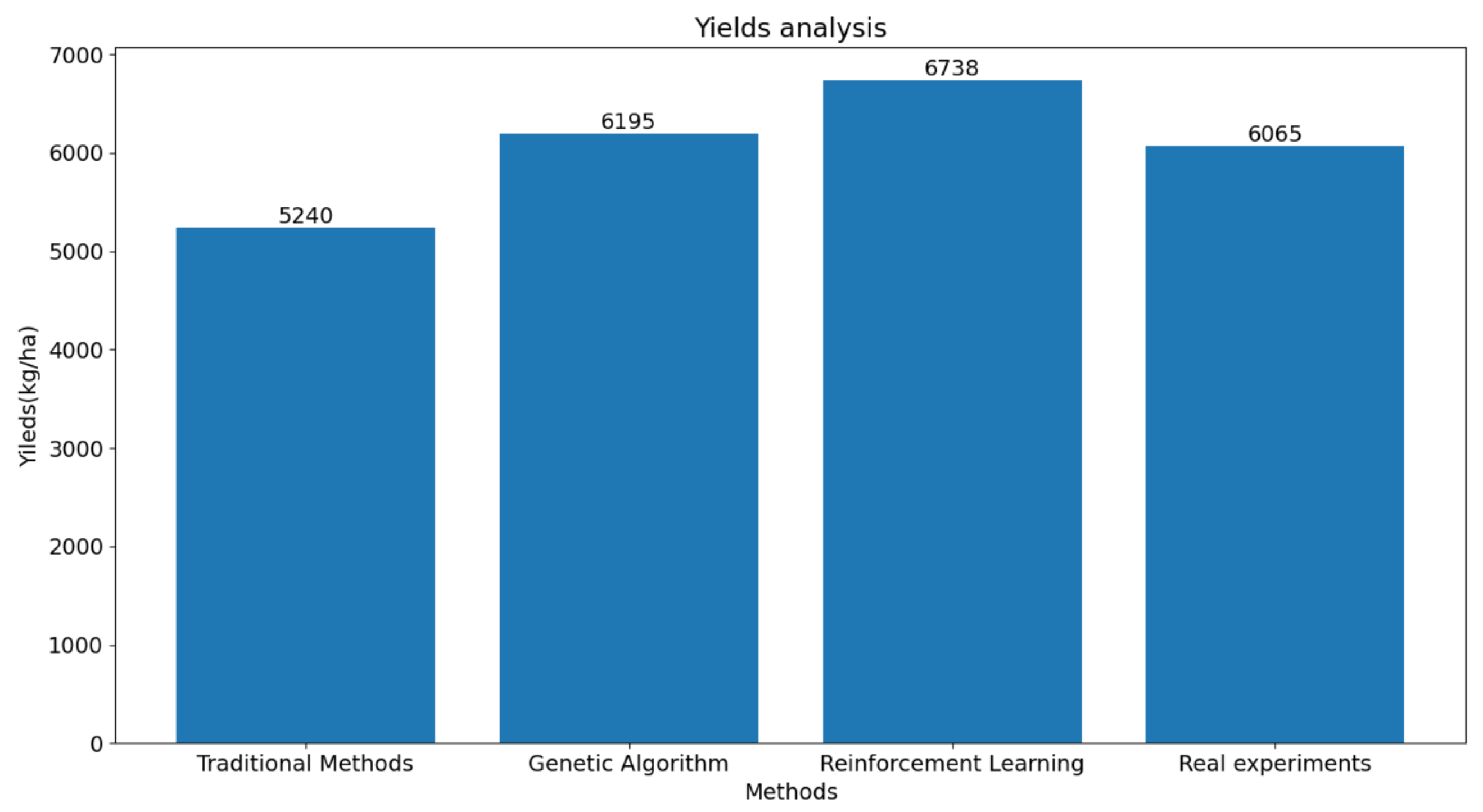
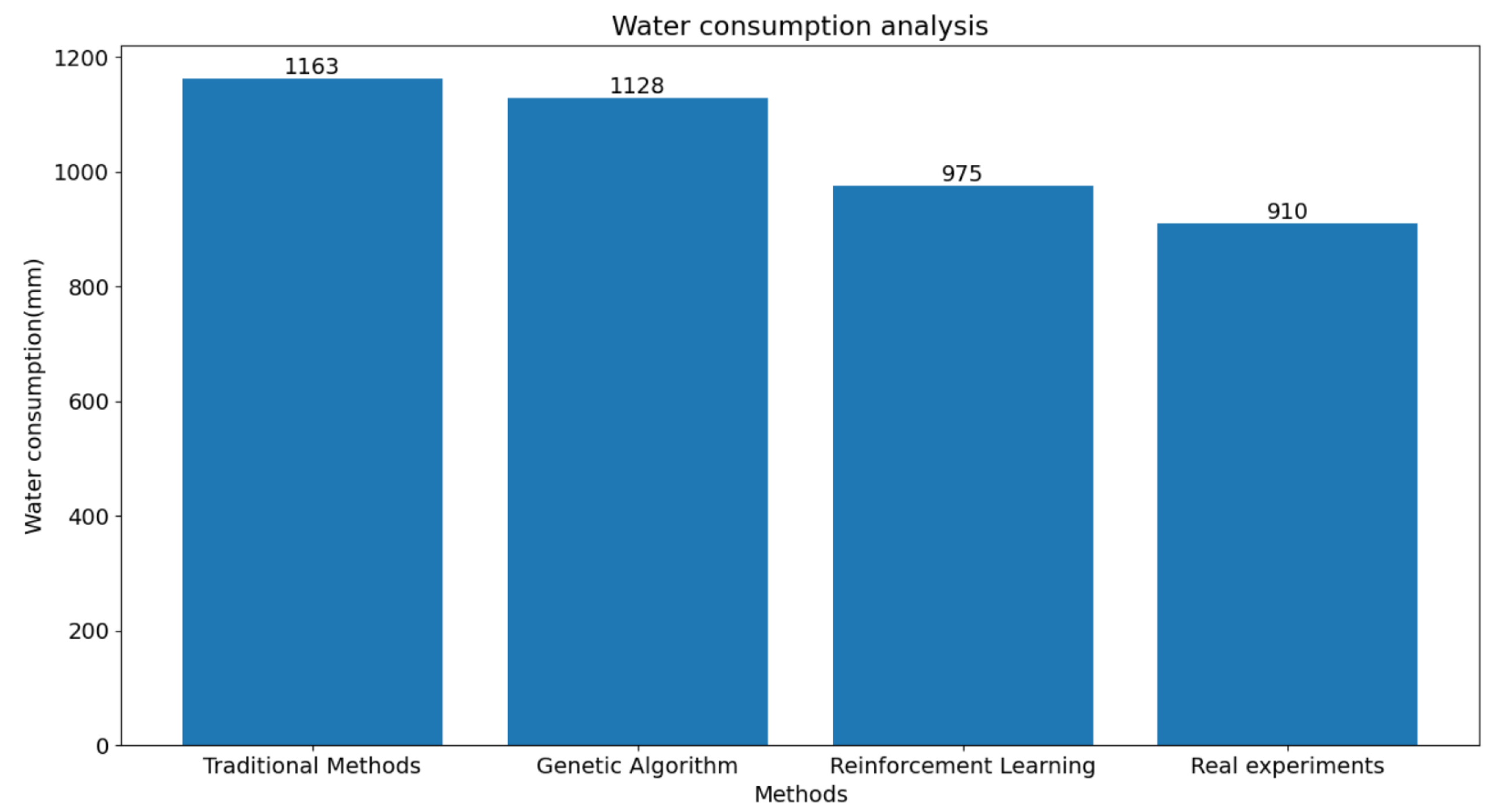

| Parameter | Definition | Range | Actual Value |
|---|---|---|---|
| CSDL | Critical Short Day Length below which reproductive development progresses with no daylength effect (for short-day plants) (hour) | 23 | 23.00 |
| PPSEN | Slope of the relative response of development to photoperiod with time (positive for short-day plants) (1/h) | 0.01 | 0.010 |
| EM-FL | Time between plant emergence and flower appearance (R1) (photothermal days) | 30–50 | 44.48 |
| FL-SH | Time between first flower and first pod (R3) (photothermal days) | 8–12 | 9.00 |
| FL-SD | Time between first flower and first seed (R5) (photothermal days) | 12–20 | 14.54 |
| SD-PM | Time between first seed (R5) and physiological maturity (R7) (photothermal days) | 40–60 | 41.85 |
| FL-LF | Time between first flower (R1) and end of leaf expansion (photothermal days) | 70.00 | 70.00 |
| LFMAX | Maximum leaf photosynthesis rate at 30 °C, 350 vpm CO2, and high light (mg CO2/m2·s) | 0.95–1.15 | 1.11 |
| SLAVR | Specific leaf area of cultivar under standard growth conditions (cm2/g) | 170–250 | 179.4 |
| SIZLF | Maximum size of full leaf (three leaflets) (cm2) | 250–300 | 284.1 |
| XFRT | Maximum fraction of daily growth that is partitioned to seed + shells | 0.5–1 | 0.95 |
| WTPSD | Maximum weight per seed (g) | 0.18 | 0.18 |
| SFDUR | Seed filling duration for pod cohort under standard growth conditions (photothermal days) | 20–40 | 20.03 |
| SDPDV | Average seed per pod under standard growing conditions (#/pod−1) | 20–30 | 20.95 |
| PODUR | Time required for cultivar to reach final pod load under optimal conditions (photothermal days) | 6–15 | 6.00 |
| THRSH | Threshing percentage; the maximum ratio of (seed/(seed+shell)) at maturity; causes seeds to stop growing as their dry weight increases until the shells are filled in a cohort | 70–80 | 72.00 |
| SDPRO | Fraction of protein in seeds (g(protein)/g−1(seed)) | 0.153 | 0.153 |
| SDLIP | Fraction of oil in seeds (g(oil)/g(seed)) | 0.12 | 0.120 |
| Reference Layer | Shallow (10–20) | Deep (40–100) |
|---|---|---|
| gravel content (%) | 7.0 | 8.0 |
| sand content (%) | 31.0 | 31.0 |
| silt content (%) | 46.0 | 43.0 |
| clay content (%) | 23.0 | 26.0 |
| reference bulk density (kg/dm3) | 1.37 | 1.35 |
| organic carbon (% weight) | 0.46 | 0.27 |
| pH | 8.3 | 8.4 |
| clay cation exchange capacity (cmol/kg) | 44.0 | 56.0 |
| cation exchange capacity (cmol/kg) | 11.0 | 13.0 |
| alkalinity (%) | 15.0 | 16.0 |
| salinity (dS/m) | 11.2 | 24.0 |
| Irrigation and Water Management | ||||
|---|---|---|---|---|
| Germinate | Day Month Year | Tr0 | Tr1 | Tr2 |
| No.1 | 20 April 2023 | 27 | 25.5 | 24 |
| No.2 | 9 June 2023 | 31.5 | 29.8 | 28 |
| No.3 | 19 June 2023 | 22.5 | 21.3 | 20 |
| No.4 | 29 June 2023 | 22.5 | 21.3 | 20 |
| No.5 | 9 July 2023 | 27 | 25.1 | 24 |
| No.6 | 14 July 2023 | 22.5 | 21.3 | 20 |
| No.7 | 21 July 2023 | 36.0 | 34 | 32 |
| No.8 | 28 July 2023 | 31.5 | 29.8 | 28 |
| No.9 | 4 August 2023 | 31.5 | 29.8 | 28 |
| No.10 | 11 August 2023 | 27.0 | 25.5 | 24 |
| No.11 | 18 August 2023 | 27.0 | 25.5 | 24 |
| No.12 | 25 August 2023 | 18.0 | 17 | 16 |
| Irrigation Treatment | Number of Plants | Simulated Yield (kg/ha) | Observe Yield (kg/ha) |
|---|---|---|---|
| Tr0-1 | 16 | 6195 | 6065.4 |
| Tr0-2 | 15 | ||
| Tr0-3 | 13 | ||
| Tr1-1 | 13 | 5732 | 5937.9 |
| Tr1-2 | 13 | ||
| Tr1-3 | 12 | ||
| Tr2-1 | 12 | 5167 | 5318.7 |
| Tr2-2 | 16 | ||
| Tr2-3 | 15 |
| State | State Example |
|---|---|
| St | [[1, 8, 15, 22, 29, 36, 43, 50, 57, 64, 71, 78, 85, 92, 99, 106, 113, 120, 127, 134, ’HWAMS’], [20, 56, 86, 64, 28, 68, 77, 94, 27, 20, 40, 30, 20, 42, 35, 41, 37, 27, 31, 56, 6013]] |
| St+1 | [[1, 8, 15, 22, 29, 36, 43, 50, 57, 64, 71, 78, 85, 92, 99, 106, 113, 120, 127, 134, ’HWAMS’], [35, 56, 86, 64, 28, 68, 77, 94, 27, 20, 40, 30, 20, 42, 35, 41, 37, 27, 31, 56, 5964]] |
| Irrigation Total | Yields (kg/ha) | Amount of Water per Kilogram | ||
|---|---|---|---|---|
| XJCJ | Traditional Methods | 1163 | 5240 | 0.22 |
| Genetic Algorithm | 1128 | 6195 | 0.18 | |
| Reinforcement Learning | 975 | 6738 | 0.14 | |
| Real Experiments | 910 | 6065 | 0.15 |
Disclaimer/Publisher’s Note: The statements, opinions and data contained in all publications are solely those of the individual author(s) and contributor(s) and not of MDPI and/or the editor(s). MDPI and/or the editor(s) disclaim responsibility for any injury to people or property resulting from any ideas, methods, instructions or products referred to in the content. |
© 2023 by the authors. Licensee MDPI, Basel, Switzerland. This article is an open access article distributed under the terms and conditions of the Creative Commons Attribution (CC BY) license (https://creativecommons.org/licenses/by/4.0/).
Share and Cite
Chen, Y.; Yu, Z.; Han, Z.; Sun, W.; He, L. A Decision-Making System for Cotton Irrigation Based on Reinforcement Learning Strategy. Agronomy 2024, 14, 11. https://doi.org/10.3390/agronomy14010011
Chen Y, Yu Z, Han Z, Sun W, He L. A Decision-Making System for Cotton Irrigation Based on Reinforcement Learning Strategy. Agronomy. 2024; 14(1):11. https://doi.org/10.3390/agronomy14010011
Chicago/Turabian StyleChen, Yi, Zhuo Yu, Zhenxiang Han, Weihong Sun, and Liang He. 2024. "A Decision-Making System for Cotton Irrigation Based on Reinforcement Learning Strategy" Agronomy 14, no. 1: 11. https://doi.org/10.3390/agronomy14010011
APA StyleChen, Y., Yu, Z., Han, Z., Sun, W., & He, L. (2024). A Decision-Making System for Cotton Irrigation Based on Reinforcement Learning Strategy. Agronomy, 14(1), 11. https://doi.org/10.3390/agronomy14010011




